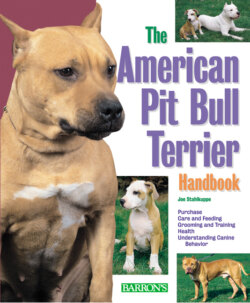Читать книгу American Pit Bull Terrier Handbook - Joe Stahlkuppe - Страница 29
На сайте Литреса книга снята с продажи.
Fighting Canines
ОглавлениеMany of the early mastiffs found their way into the arenas in far-flung corners of the Roman Empire. Fighting every kind of creature from man to lions, and even elephants, mastiffs became the epitome of savagery and fighting ability. Because these traits were highly valued in barbaric civilizations, these dogs were greatly prized and became gifts for visiting kings and noblemen. The gift of these animals to the leaders of other countries helped in the spread of mastiff genetic material.
Mastiffs were truly awesome fighting machines. Their huge size was amply complemented by vicious and savage dispositions. To augment the dogs’ natural abilities as fighters, they were often outfitted with bladed collars and armor. Used in much the same way that sappers or shock troops would be used in later warfare, these fighting dogs served both as vanguard attack forces and as diversionary tactical elements. While opposing foot soldiers were occupied battling the giant dogs, the dogs’ masters would swoop down in a cavalry charge. If the mounted battlers went in first, the mastiffs were restrained and set free at the right moment to turn the tide of a skirmish or battle.
The mastiff forces fought in many wars over many centuries. Art on ancient tombs clearly reflects an identifiable mastiff-type dog attacking mounted riders. Mastiffs were even used in the conquest of the New World when they were set on native tribes with devastating effect. Kings kept great kennels of these fierce war dogs. One Egyptian pharaoh had a retinue of over 2,000 canine fighters in his army. These impressive weapons did not go unnoticed by the conquering Romans who soon added these dogs to their forces.
Rome was successful enough at war to have sufficient disposable time and funds to bring back some of the horrors of war to the home folks. Arenas found the mastiff fighting again, and against all manner of creatures. These early dogs, often blendings of several types of mastiffs the Romans had encountered in their conquests, were often left behind in the countries that had become part of the Roman Empire. They were bred to local dogs, and many new breeds resulted. Over 40 modern breeds can directly be traced to mastiff ancestry. All of these breeds except four, the Boston Terrier, the Pug, the French Bulldog, and the Miniature Bull Terrier, are still reminiscent of the power and strength of their Mollosian forebears—the mastiffs.
The Middle Ages: During the Middle Ages, cannons and other devices of destruction were surpassed in the killing and maiming power of the mastiff regiments. These giant and still quite aggressive dogs became manor dogs guarding nobility. The big dogs became hunters to battle wolves, bears, and other marauders. They still belonged largely to the feudal lords. In England and throughout Europe giant mastiff dogs began to fill a function quite similar to that of their ancestors in the Roman arenas. Mastiffs began to be matched against beasts, first as an economic necessity, then as a mini-spectacle, and then as a fullblown “sport.”
